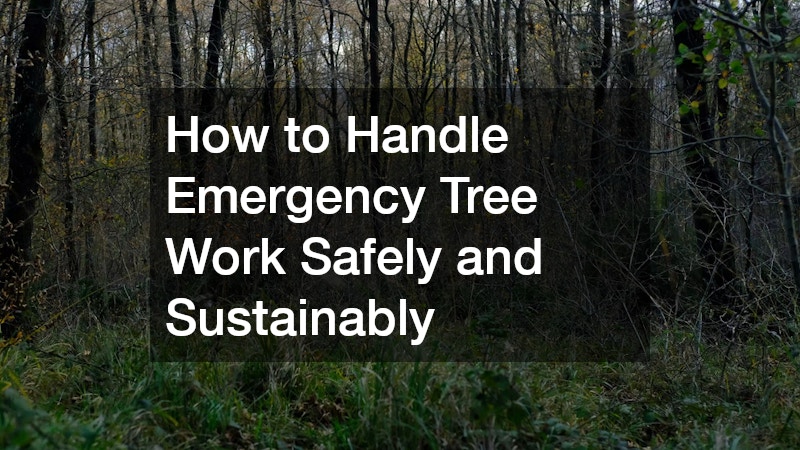When a storm strikes or an old tree becomes hazardous, emergency tree work may be necessary to protect your home, family, and property. Trees are valuable parts of any landscape, providing shade, improving air quality, and enhancing the environment. However, when branches break or trees become unstable, immediate action is essential to prevent damage or injury. Handling these situations safely and sustainably requires a careful balance of urgency, environmental awareness, and expert knowledge.
Prioritize Safety First
The top priority during any emergency tree situation is safety. Attempting to remove or trim a dangerous tree without the right skills or equipment can lead to serious accidents or property damage.
Before doing anything, assess the situation from a safe distance. Look for hanging branches, leaning trunks, or downed power lines. If power lines are involved, contact your utility company immediately and keep everyone clear of the area. Never try to handle trees near electrical wires on your own.
For other hazards, such as unstable limbs or cracked trunks, it’s best to call a professional arborist or tree service company. These experts have the training and equipment to perform emergency tree work safely. They can also evaluate whether the tree can be saved or if complete removal is necessary.
Choose Eco-Friendly Tree Services
While the urgency of emergency tree work can tempt homeowners to rush decisions, choosing environmentally responsible service providers is important. Look for companies that prioritize sustainable practices such as proper waste disposal, use of eco-friendly equipment, and minimal disruption to surrounding vegetation and wildlife habitats.
Sustainable tree services often use low-emission machinery, recycle green waste, and follow local regulations for tree protection. These practices not only safeguard the environment but also help maintain the health and beauty of your property long after the emergency is resolved.
Plan for Minimal Environmental Impact
In the rush to address an emergency, it’s easy to overlook the environmental impact of tree removal or pruning. However, even urgent work can be done thoughtfully to minimize harm. Before starting, identify nearby plants, nesting birds, or animal habitats that could be affected. Inform your tree service provider so they can adjust their approach accordingly.
Where possible, preserve parts of the tree that do not pose a risk, such as healthy branches or roots. Instead of clear-cutting, selective pruning can retain more of the tree’s benefits. When removal is necessary, consider options for recycling or repurposing the wood, such as firewood, mulch, or habitat structures.
Understand the Costs and Timing
Emergency tree work can be costly due to the urgent nature and specialized equipment required. Prices depend on the size of the tree, extent of damage, and complexity of the job. While it’s tempting to delay or DIY the work to save money, quick action often prevents more expensive repairs later.
Ask for detailed estimates from multiple providers if time allows, and prioritize those with certifications and a strong reputation for sustainable practices. Remember that fast, safe removal or pruning preserves your home’s safety and the health of your landscape.
After the Emergency: Tree Care and Recovery
Emergency tree work doesn’t always mean the tree is gone. Sometimes, pruning damaged limbs or cabling weak branches can help save the tree and extend its life. After the work is complete, monitor the tree’s health closely for signs of disease or stress.
Provide supplemental watering, mulch, and fertilization to aid recovery. These steps help reduce stress on the tree and encourage new growth after damage. Consult with an arborist to develop a long-term care plan that strengthens your trees against future storms or emergencies. Sustainable tree management promotes a healthy, resilient landscape that benefits both your property and the environment.
Preventing Future Tree Emergencies
While not all emergencies can be avoided, regular tree maintenance significantly reduces the risk. Being proactive about tree health can save you time, money, and stress in the long run. Schedule annual inspections by certified arborists to identify and address weak limbs, disease, or structural issues early. Proper pruning, watering, and fertilization keep trees strong and less prone to storm damage.
Planting native species suited to your climate and soil conditions also contributes to a more resilient landscape. A well-maintained tree canopy provides shade, reduces erosion, and supports local wildlife—making your property safer and more environmentally friendly.
Handling emergency tree work can be daunting, but prioritizing safety and sustainability ensures the best outcome for your home and the environment. When emergencies arise, assess risks carefully, enlist professional help, and choose eco-conscious tree services that minimize environmental impact. Preparing your property and understanding costs can help the process run smoothly and protect your investment.
Beyond the emergency, ongoing tree care and smart landscaping choices reduce future hazards and enhance your property’s health. By balancing urgency with responsibility, you can navigate emergency tree situations confidently, protecting both your family and the natural beauty around you.


